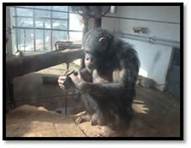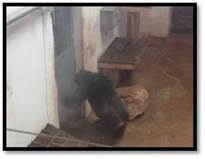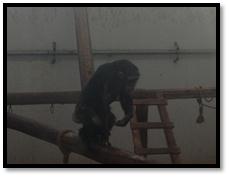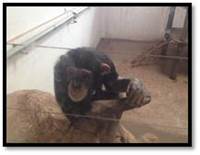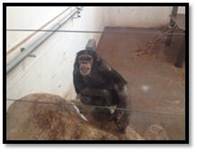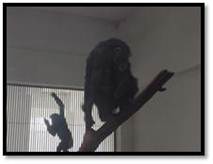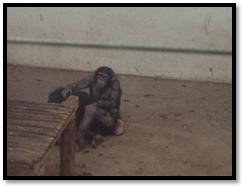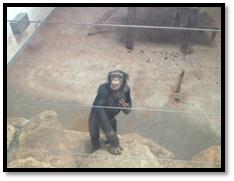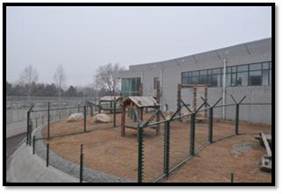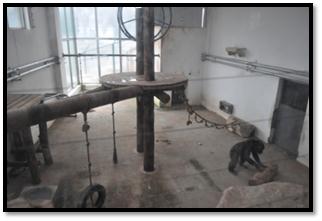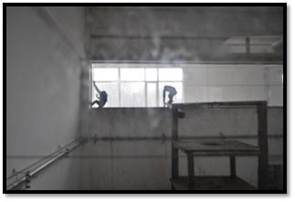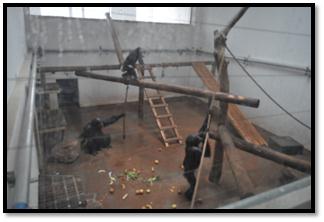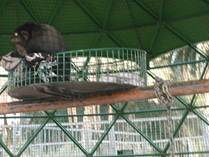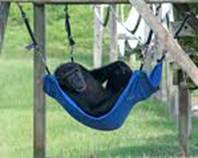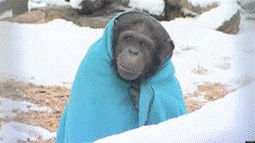
|
|
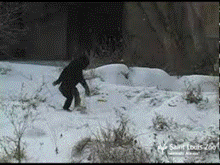 |
|
Wales Ape and Monkey Sanctuary, U.K.
|
|
Saint Louis Zoo, USA
|
Snow day for the
chimpanzees at Saint Louis Zoo
General
Propositions:
Elephants
The
Taiyuan Zoo currently has 1.0 African elephant and 1.0 Asian
elephant. The animals were housed on bare concrete with no
enrichment opportunities. They were also kept inside during
the winter.
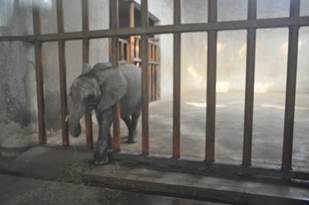
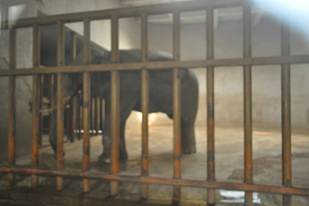
Male elephant
socialization (Please
review AZA Standards for Elephant Management and Care)
Suggestions:
Please review AZA Standards
for
Elephant Management and Care.
Adult
males (6 years and older) may be housed alone, but not in
complete isolation. Opportunities for tactile, olfactory,
visual and/or auditory interaction with other elephants must
be provided (Rasmussen et al. 1982). Each institution must
be able to demonstrate and/or describe how they will
successfully isolate and socialize males. In the wild, adult
males are primarily solitary. However, they do have regular
contact with other elephants.
Outdoor
access and temperature: Institutions
should consider designing exhibits that allow elephants outdoor
access as much as possible – weather, health, and
safety permitting. Elephants exposed to temperatures
below 40°F (5°C) for longer than 60 minutes, must be
monitored hourly to assess the potential for hypothermia. If
needed to prevent hypothermia, supplemental heat, an area of
direct sunlight protected from wind/precipitation, access to
indoor barn stalls or other options for thermal management
must be provided for the elephants.
Standard
– Outdoor – Nighttime: Elephants
kept outdoors overnight when temperatures are under 40°F (5°C),
must be provided with supplementary heat and adequate
shelter from adverse weather.
General
Suggestions for Elephant Care
Sand
needs to be added both inside the night house and on the
exhibit at a depth of one meter.
Elephants cannot be kept on concrete. It is very hard on
their feet and joints and causes severe medical problems.
Besides sand covering the floor, the elephants need a larger
pile of sand (approximately 2 meters high) to lie
down upon.
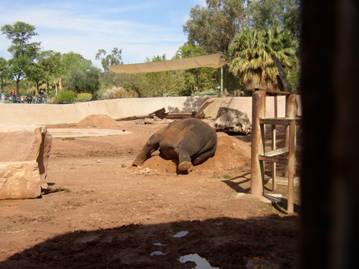
The animals should have continuous free access to
food by using feeder devices (food placed inside metal kegs
with holes, hay bags, etc.) and mostly from up high.
Hay
bags can be woven from ropes. The nets from International
Cordage are made
specifically for elephants. The zoo must contact the company
for details about rope, size, etc. The Phoenix Zoo
was the first zoo to incorporate the nets; however our nets
are prototypes.
http://www.international-cordage.net/
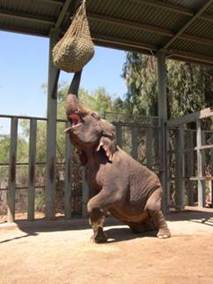
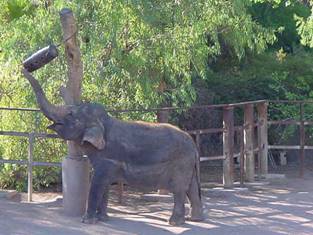
Elephants need to receive large EDIBLE tree branches
every day (please see
attached browse list for elephants).
The elephants should no longer be chained and picture
taking should be discontinued or at least reduced.
Tires can be hung from chains as enrichment.
Scratching posts made from palm trees can be chained or secured in a
safe way to the fence or the poles.
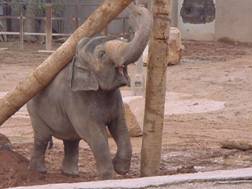
Large
tree logs (whole trees)
can
be laid all over the ground to encourage the animals to step over and/or go
around them, allowing
for added exercise.
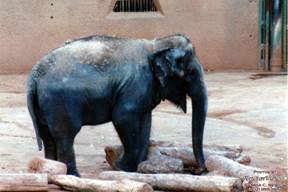
Clay wallow can
help with proper skin care and prevent sunburn.
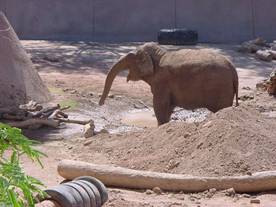
Toys such a large Planet
Balls are available at
http://boomerball.com/
<http://boomerball.com/.
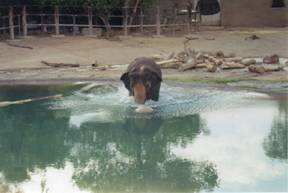
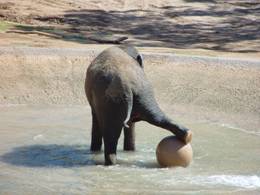
For
further information, please contact Heather Wright, Phoenix
Zoo Elephant Manager at
hwright@thephxzoo.com.
Night
Houses, Off-exhibit Areas and Correct Substrate Use
Although
hoof stock and some cats were kept in large or even
luxurious exhibits, many animals (mostly carnivores, birds,
pigs and primates) were housed on sterile surfaces close to
freezing temperature with
reduced
chance for exploratory behaviours. This practice likely
originates out of good intent to keep a clean environment
for the animals, as it appears to be a cultural inheritance
that if an exhibit is not hosed frequently, than the animals
are not being well cared for. However, this practice creates
poor conditions for the animals.
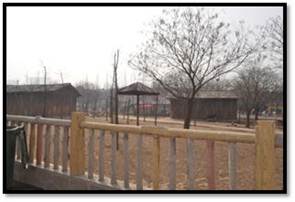
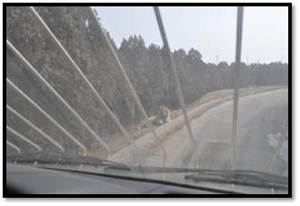
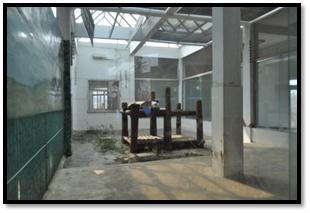
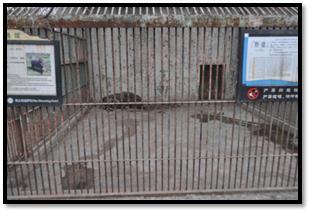
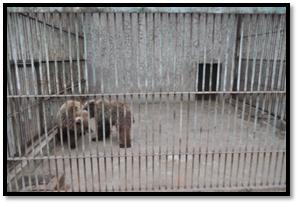
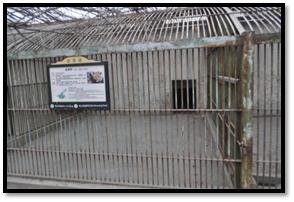
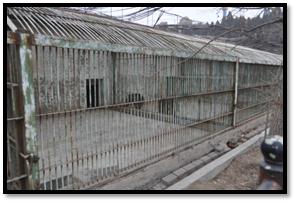
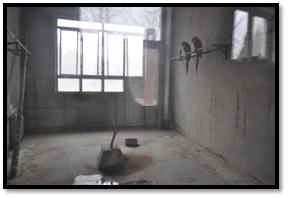
Suggestions:
Begin
keeping animals off of unyielding surfaces (brick, concrete,
etc.). The use of appropriate substrate (inside- paper
products, hay or straw, etc.; outside- nonflammable
materials such as grass, sand, soil, mulch, fresh browse,
etc.) will make a significant difference not only in the
animals’ mental and physical health, but also in the
improvement of the exhibit aesthetics. Using substrate will
reduce cleaning time and water consumption, as well.
Soaking, scrubbing and hosing dry waste takes much longer
than spot cleaning substrate due to the substrate’s
ability to absorb urine and cover fecal matter. Reducing
hosing and partially covering surface with substrate will
overcome any of these obstacles and provide animals with a
soft surface.
Night
House Conditions and Debris in Exhibits and Visitor Pathways
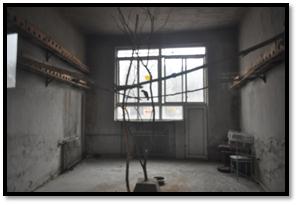
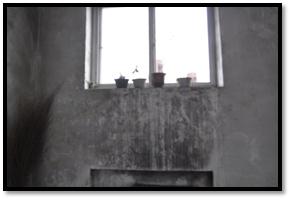
Suggestions:
Chairs, dollies and cardboard boxes should not be stored in
night houses with animals. Chipping paint should be scrubbed
off and the walls should be repainted. Garbage needs to be
removed from public ways. These problems can create
safety issues as well as making the exhibits look dirty and
unkept.
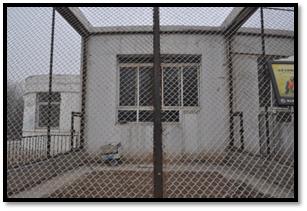
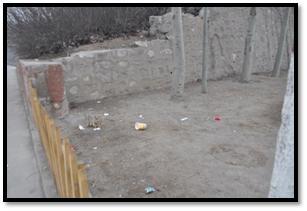
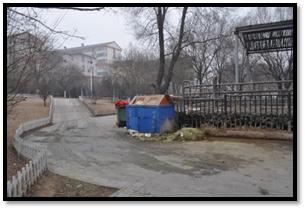

Solitary
Primates
Several
primate species were kept on bare concrete and also in
solitary confinement without any visual or tactile
opportunities with other primates.
Social isolation and reduced space allowance have been
documented to cause increased levels of aggression and
stress levels in a range of captive wild animals from
primates to dolphins.
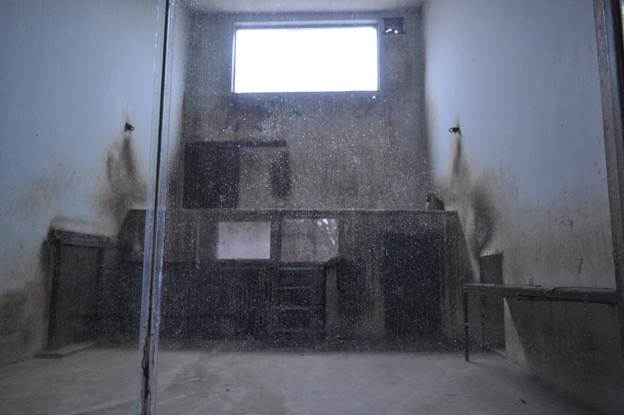
Suggestions:
Solitary
primates need to be able to see, smell and touch other
primates, even if it is a different species, until they are
paired up with their conspecific. Please review laws and
guidelines regarding social keeping of primates:
Title 9, Code of Federal Regulations, Subchapter A – Animal
Welfare Part 3 Standards, Subpart D Specifications for the
Humane Handling, Care, Treatment, and Transportation of
Nonhuman Primates, Section 3.81
Sec. 3.81 Environment enhancement to promote psychological
well-being.
Dealers, exhibitors, and research facilities must develop,
document, and follow an appropriate plan for environment
enhancement adequate to promote the psychological well-being
of nonhuman primates. The plan must be in accordance with
the currently accepted professional standards as cited in
appropriate professional journals or reference guides, and
as directed by the attending veterinarian. This plan must be
made available to APHIS upon request, and, in the case of
research facilities, to officials of any pertinent funding
agency. The plan, at a minimum, must address each of the
following:
(a) Social grouping. The
environment enhancement plan must include specific
provisions to address the social needs of nonhuman primates
of species known to exist in social groups in nature.
Individually housed nonhuman primates must be
able to see and hear nonhuman primates of their own or
compatible species unless the attending veterinarian
determines that it would endanger their health, safety, or
well-being.
Canadian Council on Animal Care,
Olfert ED, Cross BM, McWilliam AA 1993.
Guide to the Care and Use of Experimental Animals, Volume 1,
2nd Edition. Canadian Council on Animal Care, Ottawa
"The social needs of animals used in research,
teaching, or testing, should be given equal consideration
with environmental factors such as lighting, heating,
ventilations and containment (caging). Particularly in the
case of singly housed animals, daily observation provides an
alternative from of social contact for the animal and
commonly facilitates handling in that the animal becomes
accustomed to the human presence. .. Most animals should not be housed singly unless required by medical
condition, aggression, or dictates of the study. Singly
housed animals should have some degree of social contact
with others of their own kind. ... In the interest of
well-being, a social environment is desired for each animal
which will allow basic social contacts and positive social
relationships. Social behaviour assists animals to cope with
circumstances of confinement."
European Commission 2002.The
Welfare of Non-human Primates - Report of the Scientific
Committe on Animal Health and Animal Welfare.
European Commission, Strasbourg, France
http://europa.eu.int/comm/food/fs/sc/scah/out83_en.pdf
"Primates should not be
housed singly unless fully justified by health
considerations (for the animal and human handler) or
research procedures, as advised following an ethical review
process. If primates have to be singly housed, the animals
should have visual, olfactory and autitory contact with
conspecifics.”
International Primatological Society 1993.
IPS
International guidelines for the acquisition, care and
breeding of nonhuman primates, Codes of Practice 1-3. Primate
Report 35, 3-29
" A compatible conspecific probably provides more
appropriate stimulation to a captive primate than any other
potential environmental enrichment factor. ... Monkeys
should, unless there are compelling reasons for not doing
so, be housed socially. ... Young monkey should not
normally be separated from its mother at an early age (i.e.,
at 3-6 months) but should remain in contact for one year to
18 months, in most species. There is unlikely to be any
greater productivity through early weaning, in seasonally
breeding species, such as rhesus monkeys. Even in
non-seasonal breeders, any slight increase in productivity
must be offset against the resulting behavioural
abnormalities of the offspring."
National Research Council 1996.
Guide
for the Care and Use of Laboratory Animals, 7th
Edition.
National Academy Press, Washington
"Animals should be housed with the goal of
maximizing species-specific behaviors and minimizing
stress-induced behaviors.
For social species, this normally requires housing in
compatible pairs or groups."
National Research Council 1998.
The
Psychological Well-Being of Nonhuman Primates.
National Academy Press, Washington
"Social interactions are considered to be one of the
most important factors influencing the psychological
well-being of most nonhuman primates. ... The common
practice of housing rhesus monkeys singly calls for special
attention [p. 99] ... Every
effort should be made to house these [singly caged] animals
socially (in groups or pairs), but when this is not
possible, the need for single housing should be documented
by investigators and approved by the IACUC. ... The animal
technician's and caregiver's roles are pivotal to the social
support of primates, particularly animals that are singly
caged."
Browse
The
zoo has a large amount of edible vegetation available on
grounds that can provide fresh, leafy branches (browse).
Suggestions: Browse should be provided at least every 2-3 days,
but if possible, every day for animals that need it. The zoo
would benefit by planting edible trees, bushes and
even crops inside and outside of exhibits and along visitor
pathways. The bushes can provide future browsing materials
for growing collection demands. Whether cut by staff or
available by natural damage, fallen vegetation of approved
browse plants can be used rather than wasted.
Mixed
Species Exhibits
Suggestions:
Mixed species exhibits can be created in order to free up
space and create a more esthetic, complex exhibit. This will
also immediately resolve some of the solitary (otherwise
social) species problems until they are paired up with their
conspecific. Please review some photos of Phoenix Zoo
mixed exhibits:
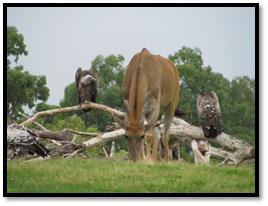
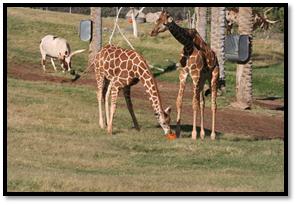
Extending
Foraging Time
Suggestions:
All animals need to be fed in a way that extends their
foraging time and encourages appropriate, species-specific
behaviors. If no one can be appointed for this position,
staff can be scheduled to cut browse and chop diet on a
rotation basis.
Smoking
Keepers
were often observed smoking, some of them inside the night
houses right next to the animals.
Suggestions: The zoo should change its smoking policy. The
first step can be creating designated smoking areas
(tables, chairs, ashtrays, garbage cans) for visitors,
directing them to these areas to smoke. Keepers should no
longer smoke in front of the visitors at all and should
absolutely not smoke inside the animals' night houses and/or
next to the animals. Keepers also need to have
designated smoking areas behind the scenes, out of the
visitors’ view.
Animal
Performances
Removing
animals from conspecifics and hand-rearing them for
performances compromises welfare, causes a lack of social
behaviors, aggression, depression, health problems and more.
Performances cause suffering to thousands of animals and “provide a
message that it is okay to use/abuse animals for
entertainment and demonstrates that the animals can only be
“controlled” by pain and fear” (Neale 2013).
The
removal of teeth and physical abuse that animals are
subjected to during circus-type performances are well-known
practices around the world and result in a
higher percentage of inactivity and/or increased
abnormal behaviour; i.e. self-injury and stereotypies.
The
lack of appropriate social interaction, reduction in time
spent foraging and the restricted freedom to perform many
highly motivated behaviours represent stressors for circus
animals. Stress can have short-term as well as chronic
long-term negative behavioural and physiological effects.
Over time this can induce poor welfare by compromising
health, altering brain function and lowering life
expectancy.
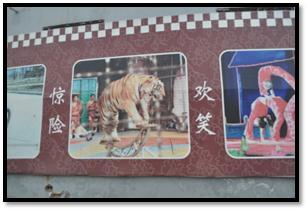
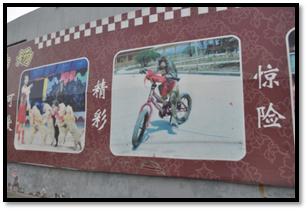
In October 2011, Ministry of Rural and Urban Housing Development issued a
directive banning animal performances in traditional zoos. Nanjing, Kunming, Shanghai, Chongqing, Zhengzhou, Jinan and Chengdu have
all closed down their animal performances (Neale 2013).
Suggestions: Ending the circus-style animal performances
and using current performing animals as ambassadors for
their wild counterparts to promote species conservation and
protection, as well as improving their housing
circumstances, will demonstrate a public commitment to
protecting the natural environment, protecting animals from
suffering and protecting species from extinction.
Incorrect
signage
Reading
animal information is a vital part of visitor education.
·
Putty-nosed monkey (Cercopithecus nictitans)
·
Bornean orangutan (Pongo pygmaeus)
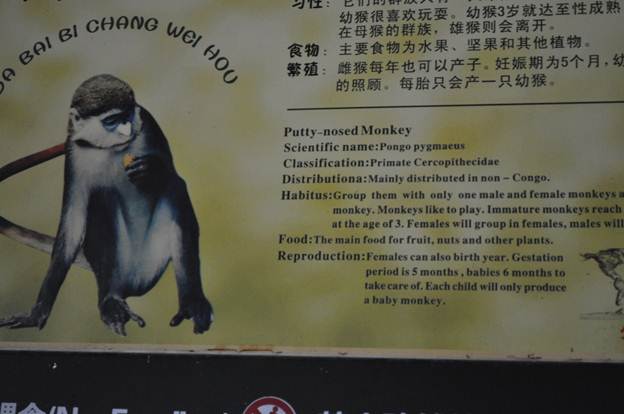
Education
The
following PowerPoint presentations were given to all staff:
·
Lack of Substrate Use in Zoos addresses
the easy fix of empty cages and shows how much benefit there
is to animals’ lives when provided with substrate; i.e.,
when they do not have to sit inside of empty concrete cages.
This is probably the most important animal welfare
presentation to give out of the four.
·
Contra Freeloading at the Phoenix Zoo
talks about making animals work for their food in similar
ways as they would in the wild, instead of eating in short
periods of time from metal dishes or rubber tubs.
·
Beneficial Browse gives guidelines regarding
how to develop a zoo-wide browse program with numerous
browse gardens in the middle of the Sonoran Desert with no
money. It also addresses the major changes that fresh, leafy
greens can make in the animals’ lives.
·
Let Them Be Elephants addresses the
changes the Phoenix Zoo made in our elephants’ lives and
how we helped their behaviors by teaching them how to forage
right and behave like normal females. It also talks about
basic husbandry, enrichment ideas and health care.
Presentations
are available at
htresz@thephxzoo.com.
I
would like to thank the Taiyuan Zoo’s director and staff,
as well as the
Chinese Association of Zoological Gardens, for
their incredible hospitality — making me feel so welcome.
I
would also like to thank Animals Asia Foundation for funding
and organizing this trip and to establish such a wonderful,
working relationship between the Jane Goodall Institute, the
Phoenix Zoo and Taiyuan Zoo.

